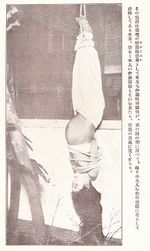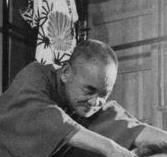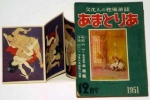Seiu Ito
Ito (伊藤) family name, Seiu (晴雨) first name, (1882-1961)
Seiu Ito was a pioneer on the subject of torment, and his pre-war illustrations and photographs had a major influence on the nascent SM world in Japan during mid 20th century. His influence continues to the present day.
Activities
Painter, Writer, Kinbakushi
Alternate Name(s)
伊藤晴雨(Japanese), Hajime Ito (伊藤一, real name)
Summary
Born in 1882, Ito was strongly attracted to scenes of torture in stories and theater plays from an early age, and he produced a large body of paintings, drawings and photographs depicting scenes of torture and kinbaku, often using his wife or mistress as his model.
By the 1910s, Ito was a newspaper illustrator and then a theater critic. He later became the head of the Performing Arts section as well as the main illustrator for the Yomiuri News. At the beginning of the Taisho period (1912-1926), he met Kaneyo Sasaki (Oyou) and Kise Sahara, two women who would eventually become his models. He deepened his study of torture art and photography, and in the closing years of Taisho, he rode the wave of the eroguro movement and attracted attention as a “painter of perversion”. In 1928, he published his first kinbaku-related book (Seme no Kenkyu – Research on Torture), which was soon after banned by the authorities.
During the Taisho period, he established theater groups whose plays centered on torture scenes. Before World War II, he published a large number of collections of graphic works through editor Suikodo Shoten. Ito was at the height of his career, but this was interrupted by the war. After the war, he worked as a writer in magazines such as Ningen Tankyu, Kitan Club and Fuzoku Soushi. In addition, he organized frequent photo sessions, and the resulting photos can be seen as “photos in the Seiyu way” in magazines such as Fuzoku Soushi, Fuzoku Kitan and Uramado. In 1953, he started the Seme no Gekidan (Torture Theater Group) which performed at Ichikawa Suzumoto theater in Tokyo and others.
He was also an historian and his lifelong research culminated in the book Iroha Biki -- Edo to Tokyo Fuzoku Yashi which details the tools and crafts of old Tokyo.
Biography
1882: Born March 3rd in Tokyo, Asakusa district, Kinryusan Kudarikawara 5, the eldest son of Kintaro Ito, a metal engraver.
1890: Accepted as an apprentice by Teiu Nozawa, a member of the Edo-based Korin school of drawing; at about nine years of age, discovers his obsession with the perfume of women’s hair as well as punishment scenes in theater plays.
1891: Receives a copy of the story of Chujou Hime (Princess Chujou) from his mother; the scene of torture in the snow leaves a strong impression.
1892: Goes with his parents to the theater Honjo Kotobukiza and watches a performance of Otono Yoshida’s Maneku Furisode (An Inviting Kimono Sleeve); the scene of torture leaves a profound mark.
1894: Becomes the apprentice of ivory carver Seisyu Naito in the district of Honjo Aioi-cho, Tokyo.
1895: Starts to collect pictures related to torture.
1896: Starts to draw advertisements for theater plays.
1896: In June, Ito goes to the Haruki Theater in the district of Hongo, Tokyo to watch Nisshin Senso Youchi no Ada Tan (Raid Nocturne During the Nishiin War), a play in the Soushi Shibai (Outlaw Theater) where a scene of a nurse being tortured leaves a deep impression.
1898: While still an apprentice ivory carver, uses his free time to draw ropes of illustrations of women published in the Tokyo Asahi newspaper.
1899: In the Tokiwa Theater in Asakusa, is strongly impressed by the torture chamber in the play Akumabarai (Sweep Away the Demons) of Yoshimi Mizuno.
1905: With the intention of becoming a painter, terminates his apprenticeship with the ivory carver and moves to Kyoto; tries different occupations in succession but eventually returns to Tokyo.
1907: Joins the Mai-Chou Shinbun published in the Nihonbashi, Tokyo district as an artist/journalist. He is put in charge of illustrating Yomashima (Ghost Island) by writer Syuhei Arigawa.
1909: Joins the Yamato Shinbun Sha located in Kyobashi, Tokyo in charge of illustrations, while continuing as theater critic at the Maiseki Shinbun; he then joined the Yomiuri Shinbun where he was promoted to head illustrator.
1909: Through an arranged introduction, he marries Takeo, the younger sister of the wife of Terunobu Tamaki (1879-1953), a scenery painter of the Shinpa (new school) movement. Around that time, having gained a steady income and numerous commissions for illustrations, most of his money was spent on entertainment.
1916: Starts a relationship with his model Kaneyo Sasaki (Oyou) and starts drawing his first torture illustrations.
1918: Kaneyo Sasaki starts living with Yumeji Takehisa (1884-1934), painter and poet.
1919: Starts the Kaidan Kai (Ghost Stories Society) in Hyakkaen park in Mukojima, Tokyo along with Rokko Hirayama (1881-1953) writer, Kogen Miyake (1886-1951) writer, (Kyoka Izumi (1873-1939) writer, Mantaro Kubota (1889-1963) writer, Saitenzan III Kinjo (1863-1935), Yoho Ii (1871-1932), Shotaro Hanayagi (1894-1965) actor.
1919: Divorces Takeo and marries Kise Sahara.
1919: With Kise Sahara, takes photos of snow torture in his garden; the photographer is YuuKa.

1920: Makes his fist attempt at suspension with his wife Kise Sahara. He also suspends his wife’s younger daughter in his workshop and takes photos.
1921: With Kise Sahara now pregnant, he creates Rinketsu Bijin Sakasa Tsuri no Shashin (Photo in Inverted Suspension of a Beautiful Woman in Her Last Month of Pregnancy).
1921: Senzaburo Suzuki (1893-1924), a theater writer, publishes Hi Aburi (Burning Her Alive), a play modeled on Seiu Ito.
1923: Borrowing a farmer's house in Shimotakaido from his student Gajou Sakamoto, he brings along photographer Raisui Suzuki to take photos of snow torture. The location was noted for the plum tree in the garden, a feature important to Ito.
1923: Great Kanto Earthquake occurs. Ito's residence escapes fire damage. At this time he had lent the Rinketsu Bijin Sakasa Tsuri no Shashin to his friend, Tomitsuka Kenzo, which is eventually published in the December 1936 issue of Hentai Shiryou; the same year he publishes Iroha Hiki – Edo to Tokyo Fuzoku Noshi (An Alphabetized Unofficial History of Edo and Tokyo Customs).
1924: Publishes photos of torture of Kise Sahara in Sunday Mainichi. He acquires a reputation for perversion.
1925: Starts a theater group which concentrates on torture scenes.
1926: The December issue of Hentai Shiriou (Pervert Documents) magazine publishes Rinketsu Bijin Sakasa Tsuri no Shashin without his authorization. Accompanied by Rinketsu no Josei no Tsukasazuri (Inverse Suspension of a Woman in Her Last Month of Pregnancy)
1927: Publication of the first volume of An Aphabetized Unofficial History of the Customs of Edo and Tokyo by publisher Hirobunkan.
1928: Publishes Torment Research which is quickly banned by the authorities.
1930: Works as contributor and editor for the Kodanzasshi.
1931: Now married for a third time, Ito's wife suffers from mental illness and he goes into debt.
1932: Publishes Ecstatic Dance of Beautiful Women.
1932: Publishes the sixth volume of his An Aphabetized Unofficial History of the Customs of Edo and Tokyo.
1933: Starts his second theater group.
1945: His home is destroyed during the Great Tokyo Air Raid.
1947: In the fourth issue of the magazine Rioki, publishes The Japanese Wife Who Wanted to Be Oppressed.
1950: In Asakusa, Tokyo, Hyakumandoru Gekijo (Million Dollar Theater) presents torture theater.
1951: Apr. Exchanges letters with Toshiyuki Suma until at least January 1954.
1951: Publishes a series of essays in the magazine Ningen Tankyuu.
1951: To celebrate the launch of the magazine Amatoria, takes part in a group travel (80 persons) to the resort of Rendaiji Onsen in Izu. Among the participants were: Nakada Masahisa (1922-), editor of noir literature; Miyake Ichirou, expert on Japanese politics; Kawakami Santaro (1891-1968), writer of comic haikus; Okada Hiroshi; Ikeda Bunchian (1902-1972), one of the first specialists in popular culture in Japan; Hayashiya Shouraku VI (1896-1966), rakugoka; Kitasato Toshio (1913-1980); Nanbu Kyoichiro (1904-1975), movie critic; Takeno Tosuke (1889-1966), writer; Ono Joutoku.
1951: Mezoku Uramono Jo (Book on Secret Things in a Women's Jail), edited by Seiu Ito and intended as a supplement to be published inside Amatoria becomes a problem and is detached from the magazine.
1953: Edits a photo supplement to the January issue of the magazine Yomikiri Romance titled Etsugyaku Koukotsu To (Graphic Depiction of Ecstasy in Pleasure and Pain) with mainly kinbaku photos; it is the second such supplement by the magazine, the first one being published in August 1952, titled Nudo Fuzoku Arubamu (Various Nude Album) and edited by Ueda Seijiro who is generally considered to have been strongly influenced by Ito. These two supplements represent the first two publications entirely devoted to kinbaku in the period following the Second World War. The photos included in Nudo Fuzoku Arubamu are seen as pre-dating the first SM works published in Kitan Club.
1953: In the January issue of Kitan Club, he publishes a short piece describing his thoughts on Reiko Kita.
1953: Starts his fourth Seme No Gekidan (Torture Theater Group) with its activity centered around the Nakamura-Za Theatre.
1953: On June 4th, the group gives its first presentation in the theater Ishikawa Suzumoto.
1953: Second group of representations at the theater Nakamura-Za in July.
1954: Meets Toshiyuki Suma for the first time in person.
1954: On January 29th, NHK channel one broadcasts a radio interview about Torment Research.
1955: Photographer Hiroshi Kawaguchi pays a visit to Seiu Ito which begins their friendship.
1956: Forms a friendship with Takashi Tsujimura.
1960: Receives a prize from the Federation of Fine Art Publishers.
1961: Seiu Ito passes away. Tetsuo Takahashi, Toshiyuki Suma, Ueda Seijiro and Masahisa Tanaka attend the funeral.
1966: Oniroku Dan's novel Ryoki no Hate (At the Extreme of Hunting for the Bizarre) is based on Seiu Ito.
1968: In the December issue of Kitan Club, Oniroku Dan publishes Shihon Itou Seiu Monogatri (Personal Writing on the Story of Seiu Ito).
1969: Some discussions are held with the Toei film company by Oniroku Dan to make a movie on the life of Seiu Ito; an agreement is not reached.
1977: Movie company Nikkatsu produces the movie Hakkinhon Bijinranpu Yori Semeru (From the Forbidden Book -- Ecstatic Dance of the Beautiful Women -- Torture!).
1978: At Jiyu Gekijo (Free Theater), Keiyu Tamai puts on the play Kiden Itou Seiu (Bizarre Stories of Seiu Ito).
1996: Oniroku Dan publishes a chronicle of Seiu Ito, Gedou no Mure (The Heretical Crowd).
2002: Gedou no Mure is made into a movie under the title Oyou.
Selected Works
There is a full bibliography in Japanese in the related article on Seiu Ito at SMpedia. Below, we have listed books on Seiu Ito which are likely to be of value to those who cannot read Japanese.
- An Aphabetized Unofficial History of the Customs of Edo and Tokyo (江戸と東京風俗野史 - いろは引) (1922-1932)
- Unofficial History of the Customs of Edo and Tokyo (江戸と東京風俗野史) (有光書房, 1997) ASIN: B000JA9AFW
- Torment Research (1928)
- Accounts of Torture (1929-9)
- Explanation of Text (1930)
- Perverse Images of Punishment in Japan (1930)
- Human Flesh Market (1947)
- Graphic History of Punishment in Japan, (two volumes). in collaboration with Fujisawa Ehiko, 1948
- Graphic History of Customs Relative to Punishment in Japan 3 vols (日本刑罰風俗図史: 上、中、下) (1948) Edited by 粋古堂. ASIN: B000JB9BSC.
- Graphic History of Customs Relative to Punishment in Japan 3 vols (日本刑罰風俗図史: 上、中、下) (2010) Complete re-edition edited by 国書刊行会. ISBN: 978-4336052179
- Torment Research (a reprint of the 1928 book), 1950
- Seme No Korekushon
- The Secret Notebooks of Seiu (伊藤晴雨・晴雨秘帖) (2002) Edited by 二見書房. ISBN: 978-4576020891
- Ecstatic Dance of Beautiful Women (美人乱舞) (1932) Book of Illustrations
- 36 Remembrances of Women (女三十六気意) (粹古堂書店, 1930)
- Torment Picture Scroll of Twelve Beautiful Women in Torment (粹古堂, 1952)
- Ito Seiu Collected Images (伊藤晴雨画集) (1997) ISBN: 978-4107200433
- Image Collection of Extreme Torture and Private Punishment of Women's Bodies
- The Yasuda Collection Vol. 5 - A Reproduction of “Woman From Hell” and “Rongo Tsukai” (安田コレクション5 地獄の女 論語通解). Private printing. 2010. no ISBN.[1]
Related Persons
Joujirou Sawada (1892-1929): Actor and theater administrator, founder of the Shinkokugeki theater group.
Goro Zoganoya (1877-1948): Actor and dramaturge.
Uzaemon XV Ichimura (1874-1945): One of the representative kabuki actors of the Taisho and early Showa period.
Keigo VI Onoe (1870-1934): Famous kabuki onnagata actor.
Ryutarou Natsumi (1905-1989): Actor, belonged to the Shinkokugeki movement.
Rokurou Kitamura (1871-1961): Kabuki onnagata actor and member of the Shinpageki, a theater genre established in 1888.
Yaeko Mizutani (1905-1979): Actress, representative of the Shinpageki which she headed after the death in 1965 of Hanayagi Shoutarou.
Shin Hasegawa (1884-1963): Novelist and theater writer.
Ranpo Edogawa (1894-1965): Novelist, first and foremost Japanese crime novel writer.
Sentaro Iwata(1901-1974): Painter, illustrator, adviser for period movies.
Ryusaburo Shikiba(1898-1965): Psychiatrist, art critic and close friend of Yukio Mishima's.
Shigeo Miyao (1902-1982): Illustrator and specialist in Edo culture.
Toshiyuki Suma, aka Reiko Kita, (1920-1992): SM illustrator.
Imasuke V Konkontei (1998-1976): Rakugoka.
Notes
- ↑ This is the 5th volume of a series of nine books dedicated to the erotic book collection amassed by Yoshida Ashiaki (1918-2008), one of the foremost experts on Japanese erotica in the 20th century (only the 5th volume contains works by Seiu Ito).

